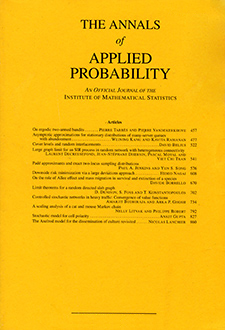Abstract
We analyse the cluster discovered by invasion percolation on a branching process with a power-law offspring distribution. Invasion percolation is a paradigm model of self-organised criticality, where criticality is approach without tuning any parameter. By performing invasion percolation for n steps, and letting , we find an infinite subtree, called the invasion percolation cluster (IPC). A notable feature of the IPC is its geometry that consists of a unique path to infinity (also called the backbone) onto which finite forests are attached. The main theorem shows the volume scaling limit of the k-cut IPC, which is the cluster containing the root when the edge between the kth and st backbone vertices is cut.
We assume a power-law offspring distribution with exponent α and analyse the IPC for different power-law regimes. In a finite-variance setting the results, are a natural extension of previous works on the branching process tree (Electron. J. Probab. 24 (2019) 1–35) and the regular tree (Ann. Probab. 35 (2008) 420–466). However, for an infinite-variance setting () or even an infinite-mean setting (), results significantly change. This is illustrated by the volume scaling of the k-cut IPC, which scales as for , but as for and exponentially for .
Funding Statement
This work is supported by the Netherlands Organisation for Scientific Research (NWO) through Gravitation-grant NETWORKS-024.002.003.
Acknowledgments
The authors thank the anonymous reviewer for their in-depth feedback and comments, which have significantly improved our paper.
Citation
Rowel Gündlach. Remco van der Hofstad. "Invasion percolation on power-law branching processes." Ann. Appl. Probab. 34 (3) 3018 - 3092, June 2024. https://doi.org/10.1214/23-AAP2032
Information





